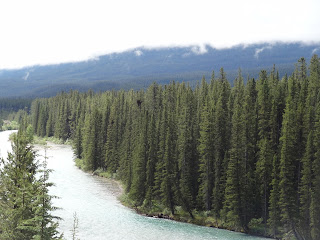Forests on the eastern slope of the Canadian
Rockies are dense stands of Lodge-Pole Pines.
These trees stand 60- to 100-feet tall and are packed so closely that
mature trees only have branches on the upper 20-30% of their narrow,
arrow-straight trunks. These branches
are quite short, and are sloughed off as they become shaded by higher
branches. Trunks at the base are only 6
to 10-inches in diameter, but their spacing is so close that you can see less
than 50-feet in any direction between the trees.
These dense forests enable a very prolific logging
industry. Each major city and many small
ones include a saw-mill as one of their major employers: supported by major
encampments of harvesters (timberjacks), truckers to fetch the lumber, road-builders
to keep the traffic flowing …
Lodge-Pole pines have a finite (50-year)
lifetime. As they grow and drop
seed-bearing pinecones, these pines germinate and terminate in large patterns
on the mountainsides.
About the only competition to the Lodge-Poles are
Aspen trees. When the pines begin to
die, the Aspens have their shot. Aspens
propagate by sending sprouts up from their roots. This means their basic need
for water is immediately met, leaving only the needs for air and sunshine. They prosper only by adaptation: In this
region, they grow as tall as the surrounding lodge-poles; They grow very
closely spaced straight, thin trunks - depending on the forest to protect them
from winds that would ordinarily bend them double; They only put leaves on the
top-most section of branches, and scuttle the lower, shaded ones. The Aspens essentially become deciduous
Lodge-Poles
… Seems Mother Nature loves a good fight.
Today's Route: Tour Miles 250-338




No comments:
Post a Comment